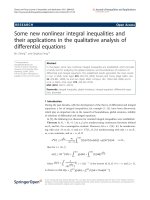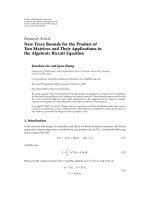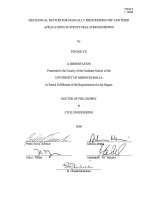- Trang chủ >>
- Khoa Học Tự Nhiên >>
- Vật lý
Determinants and their applications in mathematical physics vein r , dale p
Bạn đang xem bản rút gọn của tài liệu. Xem và tải ngay bản đầy đủ của tài liệu tại đây (1.66 MB, 393 trang )
Determinants and
Their Applications in
Mathematical Physics
Robert Vein
Paul Dale
SpringerPreface
The last treatise on the theory of determinants, by T. Muir, revised and
enlarged by W.H. Metzler, was published by Dover Publications Inc. in
1960. It is an unabridged and corrected republication of the edition origi-
nally published by Longman, Green and Co. in 1933 and contains a preface
by Metzler dated 1928. The Table of Contents of this treatise is given in
Appendix 13.
A small number of other books devoted entirely to determinants have
been published in English, but they contain little if anything of importance
that was not known to Muir and Metzler. A few have appeared in German
and Japanese. In contrast, the shelves of every mathematics library groan
under the weight of books on linear algebra, some of which contain short
chapters on determinants but usually only on those aspects of the subject
which are applicable to the chapters on matrices. There appears to be tacit
agreement among authorities on linear algebra that determinant theory is
important only as a branch of matrix theory. In sections devoted entirely
to the establishment of a determinantal relation, many authors define a
determinant by first defining a matrix M and then adding the words: “Let
det M be the determinant of the matrix M” as though determinants have
no separate existence. This belief has no basis in history. The origins of
determinants can be traced back to Leibniz (1646–1716) and their prop-
erties were developed by Vandermonde (1735–1796), Laplace (1749–1827),
Cauchy (1789–1857) and Jacobi (1804–1851) whereas matrices were not in-
troduced until the year of Cauchy’s death, by Cayley (1821–1895). In this
book, most determinants are defined directly.
vi Preface
It may well be perfectly legitimate to regard determinant theory as a
branch of matrix theory, but it is such a large branch and has such large
and independent roots, like a branch of a banyan tree, that it is capable
of leading an independent life. Chemistry is a branch of physics, but it
is sufficiently extensive and profound to deserve its traditional role as an
independent subject. Similarly, the theory of determinants is sufficiently
extensive and profound to justify independent study and an independent
book.
This book contains a number of features which cannot be found in any
other book. Prominent among these are the extensive applications of scaled
cofactors and column vectors and the inclusion of a large number of rela-
tions containing derivatives. Older books give their readers the impression
that the theory of determinants is almost entirely algebraic in nature. If
the elements in an arbitrary determinant A are functions of a continuous
variable x, then A possesses a derivative with respect to x. The formula for
this derivative has been known for generations, but its application to the
solution of nonlinear differential equations is a recent development.
The first five chapters are purely mathematical in nature and contain old
and new proofs of several old theorems together with a number of theorems,
identities, and conjectures which have not hitherto been published. Some
theorems, both old and new, have been given two independent proofs on
the assumption that the reader will find the methods as interesting and
important as the results.
Chapter 6 is devoted to the applications of determinants in mathemat-
ical physics and is a unique feature in a book for the simple reason that
these applications were almost unknown before 1970, only slowly became
known during the following few years, and did not become widely known
until about 1980. They naturally first appeared in journals on mathemat-
ical physics of which the most outstanding from the determinantal point
of view is the Journal of the Physical Society of Japan. A rapid scan of
Section 15A15 in the Index of Mathematical Reviews will reveal that most
pure mathematicians appear to be unaware of or uninterested in the out-
standing contributions to the theory and application of determinants made
in the course of research into problems in mathematical physics. These usu-
ally appear in Section 35Q of the Index. Pure mathematicians are strongly
recommended to make themselves acquainted with these applications, for
they will undoubtedly gain inspiration from them. They will find plenty
of scope for purely analytical research and may well be able to refine the
techniques employed by mathematical physicists, prove a number of con-
jectures, and advance the subject still further. Further comments on these
applications can be found in the introduction to Chapter 6.
There appears to be no general agreement on notation among writers on
determinants. We use the notion A
n
= |a
ij
|
n
and B
n
= |b
ij
|
n
, where i and
j are row and column parameters, respectively. The suffix n denotes the
order of the determinant and is usually reserved for that purpose. Rejecter
Preface vii
minors of A
n
are denoted by M
(n)
ij
, etc., retainer minors are denoted by
N
ij
, etc., simple cofactors are denoted by A
(n)
ij
, etc., and scaled cofactors
are denoted by A
ij
n
, etc. The n may be omitted from any passage if all the
determinants which appear in it have the same order. The letter D, some-
times with a suffix x, t, etc., is reserved for use as a differential operator.
The letters h, i, j, k, m, p, q, r, and s are usually used as integer param-
eters. The letter l is not used in order to avoid confusion with the unit
integer. Complex numbers appear in some sections and pose the problem
of conflicting priorities. The notation ω
2
= −1 has been adopted since the
letters i and j are indispensable as row and column parameters, respec-
tively, in passages where a large number of such parameters are required.
Matrices are seldom required, but where they are indispensable, they ap-
pear in boldface symbols such as A and B with the simple convention
A = det A, B = det B, etc. The boldface symbols R and C, with suffixes,
are reserved for use as row and column vectors, respectively. Determinants,
their elements, their rejecter and retainer minors, their simple and scaled
cofactors, their row and column vectors, and their derivatives have all been
expressed in a notation which we believe is simple and clear and we wish
to see this notation adopted universally.
The Appendix consists mainly of nondeterminantal relations which have
been removed from the main text to allow the analysis to proceed without
interruption.
The Bibliography contains references not only to all the authors men-
tioned in the text but also to many other contributors to the theory of
determinants and related subjects. The authors have been arranged in al-
phabetical order and reference to Mathematical Reviews, Zentralblatt f¨ur
Mathematik, and Physics Abstracts have been included to enable the reader
who has no easy access to journals and books to obtain more details of their
contents than is suggested by their brief titles.
The true title of this book is The Analytic Theory of Determinants with
Applications to the Solutions of Certain Nonlinear Equations of Mathe-
matical Physics, which satisfies the requirements of accuracy but lacks the
virtue of brevity. Chapter 1 begins with a brief note on Grassmann algebra
and then proceeds to define a determinant by means of a Grassmann iden-
tity. Later, the Laplace expansion and a few other relations are established
by Grassmann methods. However, for those readers who find this form of
algebra too abstract for their tastes or training, classical proofs are also
given. Most of the contents of this book can be described as complicated
applications of classical algebra and differentiation.
In a book containing so many symbols, misprints are inevitable, but we
hope they are obvious and will not obstruct our readers’ progress for long.
All reports of errors will be warmly appreciated.
We are indebted to our colleague, Dr. Barry Martin, for general advice
on computers and for invaluable assistance in algebraic computing with the
viii Preface
Maple system on a Macintosh computer, especially in the expansion and
factorization of determinants. We are also indebted by Lynn Burton for
the most excellent construction and typing of a complicated manuscript in
Microsoft Word programming language Formula on a Macintosh computer
in camera-ready form.
Birmingham, U.K. P.R. Vein
P. Dale
Contents
Preface v
1 Determinants, First Minors, and Cofactors 1
1.1 Grassmann Exterior Algebra 1
1.2 Determinants 1
1.3 First Minors and Cofactors 3
1.4 The Product of Two Determinants — 1 5
2 A Summary of Basic Determinant Theory 7
2.1 Introduction 7
2.2 Row and Column Vectors 7
2.3 Elementary Formulas 8
2.3.1 Basic Properties 8
2.3.2 Matrix-Type Products Related to Row and
Column Operations 10
2.3.3 First Minors and Cofactors; Row and Column
Expansions 12
2.3.4 Alien Cofactors; The Sum Formula 12
2.3.5 Cramer’s Formula 13
2.3.6 The Cofactors of a Zero Determinant 15
2.3.7 The Derivative of a Determinant 15
3 Intermediate Determinant Theory 16
3.1 Cyclic Dislocations and Generalizations 16
3.2 Second and Higher Minors and Cofactors 18
x Contents
3.2.1 Rejecter and Retainer Minors 18
3.2.2 Second and Higher Cofactors 19
3.2.3 The Expansion of Cofactors in Terms of Higher
Cofactors 20
3.2.4 Alien Second and Higher Cofactors; Sum
Formulas 22
3.2.5 Scaled Cofactors 23
3.3 The Laplace Expansion 25
3.3.1 A Grassmann Proof 25
3.3.2 A Classical Proof 27
3.3.3 Determinants Containing Blocks of Zero Elements . 30
3.3.4 The Laplace Sum Formula 32
3.3.5 The Product of Two Determinants — 2 33
3.4 Double-Sum Relations for Scaled Cofactors 34
3.5 The Adjoint Determinant 36
3.5.1 Definition 36
3.5.2 The Cauchy Identity 36
3.5.3 An Identity Involving a Hybrid Determinant . . . 37
3.6 The Jacobi Identity and Variants 38
3.6.1 The Jacobi Identity — 1 38
3.6.2 The Jacobi Identity — 2 41
3.6.3 Variants 43
3.7 Bordered Determinants 46
3.7.1 Basic Formulas; The Cauchy Expansion 46
3.7.2 A Determinant with Double Borders 49
4 Particular Determinants 51
4.1 Alternants 51
4.1.1 Introduction 51
4.1.2 Vandermondians 52
4.1.3 Cofactors of the Vandermondian 54
4.1.4 A Hybrid Determinant 55
4.1.5 The Cauchy Double Alternant 57
4.1.6 A Determinant Related to a Vandermondian . . . 59
4.1.7 A Generalized Vandermondian 60
4.1.8 Simple Vandermondian Identities 60
4.1.9 Further Vandermondian Identities 63
4.2 Symmetric Determinants 64
4.3 Skew-Symmetric Determinants 65
4.3.1 Introduction 65
4.3.2 Preparatory Lemmas 69
4.3.3 Pfaffians 73
4.4 Circulants 79
4.4.1 Definition and Notation 79
4.4.2 Factors 79
Contents xi
4.4.3 The Generalized Hyperbolic Functions 81
4.5 Centrosymmetric Determinants 85
4.5.1 Definition and Factorization 85
4.5.2 Symmetric Toeplitz Determinants 87
4.5.3 Skew-Centrosymmetric Determinants 90
4.6 Hessenbergians 90
4.6.1 Definition and Recurrence Relation 90
4.6.2 A Reciprocal Power Series 92
4.6.3 A Hessenberg–Appell Characteristic Polynomial . 94
4.7 Wronskians 97
4.7.1 Introduction 97
4.7.2 The Derivatives of a Wronskian 99
4.7.3 The Derivative of a Cofactor 100
4.7.4 An Arbitrary Determinant 102
4.7.5 Adjunct Functions 102
4.7.6 Two-Way Wronskians 103
4.8 Hankelians 1 104
4.8.1 Definition and the φ
m
Notation 104
4.8.2 Hankelians Whose Elements are Differences 106
4.8.3 Two Kinds of Homogeneity 108
4.8.4 The Sum Formula 108
4.8.5 Turanians 109
4.8.6 Partial Derivatives with Respect to φ
m
111
4.8.7 Double-Sum Relations 112
4.9 Hankelians 2 115
4.9.1 The Derivatives of Hankelians with Appell
Elements 115
4.9.2 The Derivatives of Turanians with Appell and
Other Elements 119
4.9.3 Determinants with Simple Derivatives of All
Orders 122
4.10 Henkelians 3 123
4.10.1 The Generalized Hilbert Determinant 123
4.10.2 Three Formulas of the Rodrigues Type 127
4.10.3 Bordered Yamazaki–Hori Determinants — 1 129
4.10.4 A Particular Case of the Yamazaki–Hori
Determinant 135
4.11 Hankelians 4 137
4.11.1 v-Numbers 137
4.11.2 Some Determinants with Determinantal Factors . 138
4.11.3 Some Determinants with Binomial and Factorial
Elements 142
4.11.4 A Nonlinear Differential Equation 147
4.12 Hankelians 5 153
4.12.1 Orthogonal Polynomials 153
xii Contents
4.12.2 The Generalized Geometric Series and Eulerian
Polynomials 157
4.12.3 A Further Generalization of the Geometric Series . 162
4.13 Hankelians 6 165
4.13.1 Two Matrix Identities and Their Corollaries 165
4.13.2 The Factors of a Particular Symmetric Toeplitz
Determinant 168
4.14 Casoratians — A Brief Note 169
5 Further Determinant Theory 170
5.1 Determinants Which Represent Particular Polynomials . . 170
5.1.1 Appell Polynomial 170
5.1.2 The Generalized Geometric Series and Eulerian
Polynomials 172
5.1.3 Orthogonal Polynomials 174
5.2 The Generalized Cusick Identities 178
5.2.1 Three Determinants 178
5.2.2 Four Lemmas 180
5.2.3 Proof of the Principal Theorem 183
5.2.4 Three Further Theorems 184
5.3 The Matsuno Identities 187
5.3.1 A General Identity 187
5.3.2 Particular Identities 189
5.4 The Cofactors of the Matsuno Determinant 192
5.4.1 Introduction 192
5.4.2 First Cofactors 193
5.4.3 First and Second Cofactors 194
5.4.4 Third and Fourth Cofactors 195
5.4.5 Three Further Identities 198
5.5 Determinants Associated with a Continued Fraction . . . 201
5.5.1 Continuants and the Recurrence Relation 201
5.5.2 Polynomials and Power Series 203
5.5.3 Further Determinantal Formulas 209
5.6 Distinct Matrices with Nondistinct Determinants 211
5.6.1 Introduction 211
5.6.2 Determinants with Binomial Elements 212
5.6.3 Determinants with Stirling Elements 217
5.7 The One-Variable Hirota Operator 221
5.7.1 Definition and Taylor Relations 221
5.7.2 A Determinantal Identity 222
5.8 Some Applications of Algebraic Computing 226
5.8.1 Introduction 226
5.8.2 Hankel Determinants with Hessenberg Elements . 227
5.8.3 Hankel Determinants with Hankel Elements 229
Contents xiii
5.8.4 Hankel Determinants with Symmetric Toeplitz
Elements 231
5.8.5 Hessenberg Determinants with Prime Elements . . 232
5.8.6 Bordered Yamazaki–Hori Determinants — 2 232
5.8.7 Determinantal Identities Related to Matrix
Identities 233
6 Applications of Determinants in Mathematical Physics 235
6.1 Introduction 235
6.2 Brief Historical Notes 236
6.2.1 The Dale Equation 236
6.2.2 The Kay–Moses Equation 237
6.2.3 The Toda Equations 237
6.2.4 The Matsukidaira–Satsuma Equations 239
6.2.5 The Korteweg–de Vries Equation 239
6.2.6 The Kadomtsev–Petviashvili Equation 240
6.2.7 The Benjamin–Ono Equation 241
6.2.8 The Einstein and Ernst Equations 241
6.2.9 The Relativistic Toda Equation 245
6.3 The Dale Equation 246
6.4 The Kay–Moses Equation 249
6.5 The Toda Equations 252
6.5.1 The First-Order Toda Equation 252
6.5.2 The Second-Order Toda Equations 254
6.5.3 The Milne-Thomson Equation 256
6.6 The Matsukidaira–Satsuma Equations 258
6.6.1 A System With One Continuous and One
Discrete Variable 258
6.6.2 A System With Two Continuous and Two
Discrete Variables 261
6.7 The Korteweg–de Vries Equation 263
6.7.1 Introduction 263
6.7.2 The First Form of Solution 264
6.7.3 The First Form of Solution, Second Proof 268
6.7.4 The Wronskian Solution 271
6.7.5 Direct Verification of the Wronskian Solution . . . 273
6.8 The Kadomtsev–Petviashvili Equation 277
6.8.1 The Non-Wronskian Solution 277
6.8.2 The Wronskian Solution 280
6.9 The Benjamin–Ono Equation 281
6.9.1 Introduction 281
6.9.2 Three Determinants 282
6.9.3 Proof of the Main Theorem 285
6.10 The Einstein and Ernst Equations 287
6.10.1 Introduction 287
xiv Contents
6.10.2 Preparatory Lemmas 287
6.10.3 The Intermediate Solutions 292
6.10.4 Preparatory Theorems 295
6.10.5 Physically Significant Solutions 299
6.10.6 The Ernst Equation 302
6.11 The Relativistic Toda Equation — A Brief Note 302
A 304
A.1 Miscellaneous Functions 304
A.2 Permutations 307
A.3 Multiple-Sum Identities 311
A.4 Appell Polynomials 314
A.5 Orthogonal Polynomials 321
A.6 The Generalized Geometric Series and Eulerian
Polynomials 323
A.7 Symmetric Polynomials 326
A.8 Differences 328
A.9 The Euler and Modified Euler Theorems on Homogeneous
Functions 330
A.10 Formulas Related to the Function (x +
√
1+x
2
)
2n
332
A.11 Solutions of a Pair of Coupled Equations 335
A.12 B¨acklund Transformations 337
A.13 Muir and Metzler, A Treatise on the Theory of
Determinants 341
Bibliography 343
Index 373
1
Determinants, First Minors, and
Cofactors
1.1 Grassmann Exterior Algebra
Let V be a finite-dimensional vector space over a field F . Then, it is known
that for each non-negative integer m, it is possible to construct a vector
space Λ
m
V . In particular, Λ
0
V = F ,ΛV = V , and for m ≥ 2, each vector
in Λ
m
V is a linear combination, with coefficients in F, of the products of
m vectors from V .
If x
i
∈ V ,1≤ i ≤ m, we shall denote their vector product by x
1
x
2
···x
m
.
Each such vector product satisfies the following identities:
i. x
1
x
2
···x
r−1
(ax + by)x
r+1
···x
n
= ax
1
x
2
···x
r−1
xx
r+1
···x
n
+bx
1
x
2
···x
r−1
y ···x
r+1
···x
n
, where a, b ∈ F and x, y ∈ V .
ii. If any two of the x’s in the product x
1
x
2
···x
n
are interchanged, then
the product changes sign, which implies that the product is zero if two
or more of the x’s are equal.
1.2 Determinants
Let dim V = n and let e
1
, e
2
, ,e
n
be a set of base vectors for V . Then,
if x
i
∈ V ,1≤ i ≤ n, we can write
x
i
=
n
k=1
a
ik
e
k
,a
ik
∈ F. (1.2.1)
2 1. Determinants, First Minors, and Cofactors
It follows from (i) and (ii) that
x
1
x
2
···x
n
=
n
k
1
=1
···
n
k
n
=1
a
1k
1
a
2k
2
···a
nk
n
e
k
1
e
k
2
···e
k
n
. (1.2.2)
When two or more of the k’s are equal, e
k
1
e
k
2
···e
k
n
= 0. When the k’s are
distinct, the product e
k
1
e
k
2
···e
k
n
can be transformed into ±e
1
e
2
···e
n
by
interchanging the dummy variables k
r
in a suitable manner. The sign of
each term is unique and is given by the formula
x
1
x
2
···x
n
=
(n! terms)
σ
n
a
1k
1
a
2k
2
···a
nk
n
e
1
e
2
···e
n
, (1.2.3)
where
σ
n
= sgn
1234··· (n − 1) n
k
1
k
2
k
3
k
4
··· k
n−1
k
n
(1.2.4)
and where the sum extends over all n! permutations of the numbers k
r
,
1 ≤ r ≤ n. Notes on permutation symbols and their signs are given in
Appendix A.2.
The coefficient of e
1
e
2
···e
n
in (1.2.3) contains all n
2
elements a
ij
,
1 ≤ i, j ≤ n, which can be displayed in a square array. The coefficient
is called a determinant of order n.
Definition.
A
n
=
a
11
a
12
··· a
1n
a
21
a
22
··· a
2n
a
n1
a
n2
··· a
nn
n
=
(n! terms)
σ
n
a
1k
1
a
2k
2
···a
nk
n
. (1.2.5)
The array can be abbreviated to |a
ij
|
n
. The corresponding matrix is
denoted by [a
ij
]
n
. Equation (1.2.3) now becomes
x
1
x
2
···x
n
= |a
ij
|
n
e
1
e
2
···e
n
. (1.2.6)
Exercise. If
12··· n
j
1
j
2
··· j
n
is a fixed permutation, show that
A
n
= |a
ij
|
n
=
n! terms
k
1
, ,k
n
sgn
j
1
j
2
··· j
n
k
1
k
2
··· k
n
a
j
1
k
1
a
j
2
k
2
···a
j
n
k
n
=
n! terms
k
1
, ,k
n
sgn
j
1
j
2
··· j
n
k
1
k
2
··· k
n
a
k
1
j
1
a
k
2
j
2
···a
k
n
j
n
.
1.3 First Minors and Cofactors 3
1.3 First Minors and Cofactors
Referring to (1.2.1), put
y
i
= x
i
− a
ij
e
j
=(a
i1
e
1
+ ···+ a
i,j−1
e
j−1
)+(a
i,j+1
e
j+1
+ ···+ a
in
e
n
) (1.3.1)
=
n−1
k=1
a
ik
e
k
, (1.3.2)
where
e
k
= e
k
1 ≤ k ≤ j −1
= e
k+1
,j≤ k ≤ n −1 (1.3.3)
a
ik
= a
ik
1 ≤ k ≤ j −1
= a
i,k+1
,j≤ k ≤ n −1. (1.3.4)
Note that each a
ik
is a function of j.
It follows from Identity (ii) that
y
1
y
2
···y
n
= 0 (1.3.5)
since each y
r
is a linear combination of (n −1) vectors e
k
so that each of
the (n − 1)
n
terms in the expansion of the product on the left contains at
least two identical e’s. Referring to (1.3.1) and Identities (i) and (ii),
x
1
···x
i−1
e
j
x
i+1
···x
n
=(y
1
+ a
1j
e
j
)(y
2
+ a
2j
e
j
) ···(y
i−1
+ a
i−1,j
e
j
)
e
j
(y
i+1
+ a
i+1,j
e
j
) ···(y
n
+ a
nj
e
j
)
= y
1
···y
i−1
e
j
y
i+1
···y
n
(1.3.6)
=(−1)
n−i
(y
1
···y
i−1
y
i+1
···y
n
)e
j
. (1.3.7)
From (1.3.2) it follows that
y
1
···y
i−1
y
i+1
···y
n
= M
ij
(e
1
e
2
···e
n−1
), (1.3.8)
where
M
ij
=
σ
n−1
a
1k
1
a
2k
2
···a
i−1,k
i−1
a
i+1,k
i+1
···a
n−1,k
n−1
(1.3.9)
and where the sum extends over the (n −1)! permutations of the numbers
1, 2, ,(n − 1). Comparing M
ij
with A
n
, it is seen that M
ij
is the deter-
minant of order (n −1) which is obtained from A
n
by deleting row i and
column j, that is, the row and column which contain the element a
ij
. M
ij
is therefore associated with a
ij
and is known as a first minor of A
n
.
Hence, referring to (1.3.3),
x
1
···x
i−1
e
j
x
i+1
···x
n
=(−1)
n−i
M
ij
(e
1
e
2
···e
n−1
)e
j
4 1. Determinants, First Minors, and Cofactors
=(−1)
n−i
M
ij
(e
1
···e
j−1
)(e
j
···e
n−1
)e
j
=(−1)
n−i
M
ij
(e
1
···e
j−1
)(e
j+1
···e
n
)e
j
=(−1)
i+j
M
ij
(e
1
e
2
···e
n
). (1.3.10)
Now, e
j
can be regarded as a particular case of x
i
as defined in (1.2.1):
e
j
=
n
k=1
a
ik
e
k
,
where
a
ik
= δ
jk
.
Hence, replacing x
i
by e
j
in (1.2.3),
x
1
···x
i−1
e
j
x
i+1
···x
n
= A
ij
(e
1
e
2
···e
n
), (1.3.11)
where
A
ij
=
σ
n
a
1k
1
a
2k
2
···a
ik
i
···a
nk
n
,
where
a
ik
i
=0 k
i
= j
=1 k
i
= j.
Referring to the definition of a determinant in (1.2.4), it is seen that A
ij
is
the determinant obtained from |a
ij
|
n
by replacing row i by the row
[0 010 0],
where the element 1 is in column j. A
ij
is known as the cofactor of the
element a
ij
in A
n
.
Comparing (1.3.10) and (1.3.11),
A
ij
=(−1)
i+j
M
ij
. (1.3.12)
Minors and cofactors should be written M
(n)
ij
and A
(n)
ij
but the parameter
n can be omitted where there is no risk of confusion.
Returning to (1.2.1) and applying (1.3.11),
x
1
x
2
···x
n
= x
1
···x
i−1
n
k=1
a
ik
e
k
x
i+1
···x
n
=
n
k=1
a
ik
(x
1
···x
i−1
e
k
x
i+1
···x
n
)
=
n
k=1
a
ik
A
ik
e
1
e
2
···e
n
. (1.3.13)
1.4 The Product of Two Determinants — 1 5
Comparing this result with (1.2.5),
|a
ij
|
n
=
n
k=1
a
ik
A
ik
(1.3.14)
which is the expansion of |a
ij
|
n
by elements from row i and their cofactors.
From (1.3.1) and noting (1.3.5),
x
1
x
2
···x
n
=(y
1
+ a
1j
e
j
)(y
2
+ a
2j
e
j
) ···(y
n
+ a
nj
e
j
)
= a
1j
e
j
y
2
y
3
···y
n
+ a
2j
y
1
e
j
y
3
···y
n
+ ···+ a
nj
y
1
y
2
···y
n−1
e
j
=(a
1j
A
1j
+ a
2j
A
2j
+ ···+ a
nj
A
nj
)e
1
e
2
···e
n
=
n
k=1
a
kj
A
kj
e
1
e
2
···e
n
. (1.3.15)
Comparing this relation with (1.2.5),
|a
ij
|
n
=
n
k=1
a
kj
A
kj
(1.3.16)
which is the expansion of |a
ij
|
n
by elements from column j and their
cofactors.
1.4 The Product of Two Determinants — 1
Put
x
i
=
n
k=1
a
ik
y
k
,
y
k
=
n
j=1
b
kj
e
j
.
Then,
x
1
x
2
···x
n
= |a
ij
|
n
y
1
y
2
···y
n
,
y
1
y
2
···y
n
= |b
ij
|
n
e
1
e
2
···e
n
.
Hence,
x
1
x
2
···x
n
= |a
ij
|
n
|b
ij
|
n
e
1
e
2
···e
n
. (1.4.1)
But,
x
i
=
n
k=1
a
ik
n
j=1
b
kj
e
j
6 1. Determinants, First Minors, and Cofactors
=
n
j=1
c
ij
e
j
,
where
c
ij
=
n
k=1
a
ik
b
kj
. (1.4.2)
Hence,
x
1
x
2
···x
n
= |c
ij
|
n
e
1
e
2
···e
n
. (1.4.3)
Comparing (1.4.1) and (1.4.3),
|a
ij
|
n
|b
ij
|
n
= |c
ij
|
n
. (1.4.4)
Another proof of (1.4.4) is given in Section 3.3.5 by applying the Laplace
expansion in reverse.
The Laplace expansion formula is proved by both a Grassmann and a
classical method in Chapter 3 after the definitions of second and higher
rejector and retainor minors and cofactors.
2
A Summary of Basic Determinant
Theory
2.1 Introduction
This chapter consists entirely of a summary of basic determinant theory, a
prerequisite for the understanding of later chapters. It is assumed that the
reader is familiar with these relations, although not necessarily with the
notation used to describe them, and few proofs are given. If further proofs
are required, they can be found in numerous undergraduate textbooks.
Several of the relations, including Cramer’s formula and the formula for
the derivative of a determinant, are expressed in terms of column vec-
tors, a notation which is invaluable in the description of several analytical
processes.
2.2 Row and Column Vectors
Let row i (the ith row) and column j (the jth column) of the determinant
A
n
= |a
ij
|
n
be denoted by the boldface symbols R
i
and C
j
respectively:
R
i
=
a
i1
a
i2
a
i3
···a
in
,
C
j
=
a
1j
a
2j
a
3j
···a
nj
T
(2.2.1)
where T denotes the transpose. We may now write
8 2. A Summary of Basic Determinant Theory
A
n
=
R
1
R
2
R
3
.
.
.
R
n
=
C
1
C
2
C
3
···C
n
. (2.2.2)
The column vector notation is clearly more economical in space and will
be used exclusively in this and later chapters. However, many properties
of particular determinants can be proved by performing a sequence of row
and column operations and in these applications, the symbols R
i
and C
j
appear with equal frequency.
If every element in C
j
is multiplied by the scalar k, the resulting vector
is denoted by kC
j
:
kC
j
=
ka
1j
ka
2j
ka
3j
···ka
nj
T
.
If k = 0, this vector is said to be zero or null and is denoted by the boldface
symbol O.
If a
ij
is a function of x, then the derivative of C
j
with respect to x is
denoted by C
j
and is given by the formula
C
j
=
a
1j
a
2j
a
3j
···a
nj
T
.
2.3 Elementary Formulas
2.3.1 Basic Properties
The arbitrary determinant
A = |a
ij
|
n
=
C
1
C
2
C
3
···C
n
,
where the suffix n has been omitted from A
n
, has the properties listed
below. Any property stated for columns can be modified to apply to rows.
a. The value of a determinant is unaltered by transposing the elements
across the principal diagonal. In symbols,
|a
ji
|
n
= |a
ij
|
n
.
b. The value of a determinant is unaltered by transposing the elements
across the secondary diagonal. In symbols
|a
n+1−j,n+1−i
|
n
= |a
ij
|
n
.
c. If any two columns of A are interchanged and the resulting determinant
is denoted by B, then B = −A.
2.3 Elementary Formulas 9
Example.
C
1
C
3
C
4
C
2
= −
C
1
C
2
C
4
C
3
=
C
1
C
2
C
3
C
4
.
Applying this property repeatedly,
i.
C
m
C
m+1
···C
n
C
1
C
2
···C
m−1
=(−1)
(m−1)(n−1)
A,
1 <m<n.
The columns in the determinant on the left are a cyclic permutation
of those in A.
ii.
C
n
C
n−1
C
n−2
···C
2
C
1
=(−1)
n(n−1)/2
A.
d. Any determinant which contains two or more identical columns is zero.
C
1
···C
j
···C
j
···C
n
=0.
e. If every element in any one column of A is multiplied by a scalar k and
the resulting determinant is denoted by B, then B = kA.
B =
C
1
C
2
···(kC
j
) ···C
n
= kA.
Applying this property repeatedly,
|ka
ij
|
n
=
(kC
1
)(kC
2
)(kC
3
) ···(kC
n
)
= k
n
|a
ij
|
n
.
This formula contrasts with the corresponding matrix formula, namely
[ka
ij
]
n
= k[a
ij
]
n
.
Other formulas of a similar nature include the following:
i. |(−1)
i+j
a
ij
|
n
= |a
ij
|
n
,
ii. |ia
ij
|
n
= |ja
ij
|
n
= n!|a
ij
|
n
,
iii. |x
i+j−r
a
ij
|
n
= x
n(n+1−r)
|a
ij
|
n
.
f. Any determinant in which one column is a scalar multiple of another
column is zero.
C
1
···C
j
···(kC
j
) ···C
n
=0.
g. If any one column of a determinant consists of a sum of m subcolumns,
then the determinant can be expressed as the sum of m determinants,
each of which contains one of the subcolumns.
C
1
···
m
s=1
C
js
···C
n
=
m
s=1
C
1
···C
js
···C
n
.
Applying this property repeatedly,
m
s=1
C
1s
···
m
s=1
C
js
···
m
s=1
C
ns
10 2. A Summary of Basic Determinant Theory
=
m
k
1
=1
m
k
2
=1
···
m
k
n
=1
C
1k
1
···C
jk
j
···C
nk
n
n
.
The function on the right is the sum of m
n
determinants. This identity
can be expressed in the form
m
k=1
a
(k)
ij
n
=
m
k
1
,k
2
, ,k
n
=1
a
(k
j
)
ij
n
.
h. Column Operations. The value of a determinant is unaltered by adding
to any one column a linear combination of all the other columns. Thus,
if
C
j
= C
j
+
n
r=1
k
r
C
r
k
j
=0,
=
n
r=1
k
r
C
r
,k
j
=1,
then
C
1
C
2
···C
j
···C
n
=
C
1
C
2
···C
j
···C
n
.
C
j
should be regarded as a new column j and will not be confused
with the derivative of C
j
. The process of replacing C
j
by C
j
is called a
column operation and is extensively applied to transform and evaluate
determinants. Row and column operations are of particular importance
in reducing the order of a determinant.
Exercise. If the determinant A
n
= |a
ij
|
n
is rotated through 90
◦
in the
clockwise direction so that a
11
is displaced to the position (1,n), a
1n
is dis-
placed to the position (n, n), etc., and the resulting determinant is denoted
by B
n
= |b
ij
|
n
, prove that
b
ij
= a
j,n−i
B
n
=(−1)
n(n−1)/2
A
n
.
2.3.2 Matrix-Type Products Related to Row and Column
Operations
The row operations
R
i
=
3
j=i
u
ij
R
j
,u
ii
=1, 1 ≤ i ≤ 3; u
ij
=0, i>j, (2.3.1)









